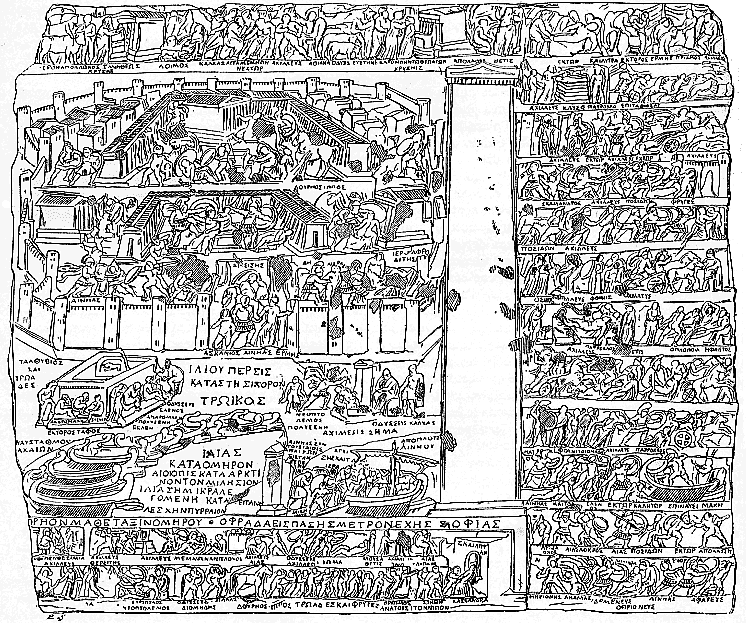
Click to get a 3204 x 2493 picture |
Th. Schreiber - Atlas of Classical Antiquities - London (1895), pp.176-179
[PLATE XCII A AND] XCIII.
The Capitoline "Tabula Iliaca."
MARBLE (Palombino) SLAB WITH FIGURES IN VERY LOW RELIEF AND INSCRIPTIONS 10 IN. HIGH BY 11½ WIDE. ROMAN, AUGUSTAN PERIOD. FOUND IN 1683 AT THE OSTERIA DELLE FRATOCCHIE NEAR THE SITE OF THE ANCIENT BOVILLAE, NOW IN THE CAPITOLINE MUSEUM, ROME. [PL. 92a GIVES AN ACCURATE], PL. 93, A PARTLY RESTORED DRAWING OF THE ORIGINAL.
JAHN, Bilderchroniken, Pl. i. (references to the literature before 1873).
BAUMEISTER, Denkmäler, fig. 775.
ENGELMANN AND ANDERSON, Atlas to Homer, Il. fig. 3.
HELEIG, Führer, p. 345 (No. 451 ; references).
Scenes taken from the Homeric and other Epic poems are found on Greek vase-paintings as early as the seventh century, and there is no lack of literary testimony to show that the same subjects were equally popular on more costly works of art, such for instance as the Chest of Cypselus. It was not however until Hellenistic times that it became usual to depict Epic scenes in regular sequence following the story as told in poetry. In earlier periods the artist troubled but little about the literary version of the story or the order in which the episodes followed one another. In the Hellenistic age he had become an illustrator and followed the poems closely.
One of the earliest recorded cycles of Epic pictures is the mosaic in Hiero's colossal ship (248 B.C.) which contained the whole story of the Iliad. The painter Theon (or Theorus) produced a Trojan War in several pictures which was afterwards brought to Rome. A series of frescoes discovered in a house on the Esquiline Hill in 1848 gives a good idea of what these pictures were like. They represent scenes from the story told by Ulysses to Alcinous in the Odyssey ; Circe, the Cyclops, Laestrygonians, the Descent to Hades. Scenes from these cycles were also very popular as ornaments for cups of metal or clay. Many "Homeric" bowls of red Samian ware have been discovered, and have been recently described by Professor Robert (50tes Winckelmannsfestprogram 1890, pp. 1-96, "Homerische Becher"). They are decorated with scenes from the Iliad, Odyssey, Aethiopis, Little Iliad, Iliupersis, and the Theban Cycle, which are accompanied by inscriptions giving the names of the heroes and quotations from the poet. The influence of such works of art, suggested by the literary tendencies of the time, reacted on literature. Virgil's pictures of the Trojan War seem to be derived almost as much from such paintings as from literature. When Aeneas visits the temple of Junon at Carthage "videt Iliacas ex ordine pugnas", a quotation that might be applied to the poet himself.
The "Tabula Iliaca" bears the title ΤΡΩΙΚΟΣ (sc. πίναξ) and gives an encyclopaedic series of illustrations of the Trojan War, drawn from the Sack of Troy by Stesichorus (ΙΛΙΟΥΠΕΡΣΙΣ ΚΑΤΑ ΣΤΗΣΙΧΟΡΟΝ), the Iliad of Homer (ΙΛΙΑΣ ΚΑΤΑ ΟΜΗΡΟΝ), the Aethiopis of Arctinus the Milesian (ΑΙΘΙΟΠΙΣ ΚΑΤΑ ΑΡΚΤΙΝΟΝ ΤΟΝ ΜΙΛΗΣΙΟΝ), and the Little Iliad of Lesches of Pyrrha (ΙΛΙΑΣ Η ΜΙΚΡΑ ΛΕΓΟΜΕΝΗ ΚΑΤΑ ΛΕΣΧΗΝ ΠΥΡΡΑΙΟΝ).
It is arranged architecturally. Two pillars (that on the left has been broken off) stand on a basis and form the frame for the "Sack of Troy." At the top, in a frieze, are scenes from the first book of the Iliad. On the left were scenes from books II. to XII, on the right scenes from the remaining twelve books. On the basis in the centre are scenes from the Aethiopis. All these are accompanied by titles giving the names of the characters and the leading incidents.
On the remaining pillar is a summary of the seventh and following books, the thirteenth, fourteenth, and fifteenth being omitted. It begins οἱ δ’ Ἀχαιοὶ τ(ε)ῖχός τε καὶ τάφρον ποιοῦνται περὶ τὰς ναῦς. Ἀμφοτέρων δ’ αὐτῶν ἐξοπλισθέντων καὶ μάχην ἐν τῷ πεδίῳ συναψάντων οἱ Τρῶες εἰς τὸ τ(ε)ῖχος τοὺς Ἀχαιοὺς καταδιώκουσιν καὶ τὴν νύκτ’ ἐκείνην ἐπὶ ταῖς ναυσὶν ποιοῦνται τὴν ἔπαθλιν κ.τ.λ.. The lost pillar gave the summary of the earlier books.
An inscription on the basis supporting the pillar gives the designer's name :
ὦ φίλε παῖ, Θεο]δώρηον μάθε τάξιν Ὁμήρου
ὄφρα δαεὶς πάσης μέτρον ἔχῃς σοφίας
" Learn, dear boy, Theodorus's setting of Homer
That from its lesson, thou mayst possess the measure of all wisdom,"
a motto which reminds one of Horace, who says of Homer, "Qui quid pulchrum, quid turpe, quid utile, quid non, planius ac melius Chrysippo et Crantore dicit," Epp. 1, 2, 3, 4. There can be no doubt as to the restoration of the name Theodorus, for he must be the person mentioned as the author of a summary by Strabo XIII. 3 (c. 625), in his list of Pergamene celebrities. καὶ Ἀπολλόδωρος ὁ ῥήτωρ ὁ τὰς τέχνας συγγράψας καὶ τὴν Ἀπολλοδώρειον αἵρεσιν παραγαγών, ἥτις ποτ’ ἐστί· πολλὰ γὰρ ἐπεκράτει, μείζονα δὲ ἢ καθ’ ἡμᾶς ἔχοντα τὴν κρίσιν, ὧν ἔστι καὶ ἡ Ἀπολλοδώρειος αἵρεσις καὶ ἡ Θεοδώρειος.. "Apollodorus the rhetorician, who made an encyclopaedia of the arts and founded 'the sect of Apollodorus,' whatever that may be ; for many schools flourished which demand a criticism that is, beyond us, and among these are both the 'sect of Apollodorus' and that of Theodorus."
It is not easy to say with certainty what purpose the "Tabula" served. Jahn assumed that it was for use in school, but it is so small that only one boy at a time could use it. Besides, even though it is unfinished it is a good piece of work with scenes copied from famous originals, and seems too ambitious and valuable to commit to the rough treatment of a school. It was more probably intended to be an ornamental panel in a bookcase or case. If so it is the oldest instance of the use of framed tablets, so general in the middle ages, to give scenes from the Bible and legends in a convenient form for private devotion. Like the mediaeval triptychs, it is no doubt closely connected with the manuscript illustrations of the period, both giving a picture gallery of the best-known representations of classic scenes.
The scenes are arranged as follows : Iliupersis in the centre.
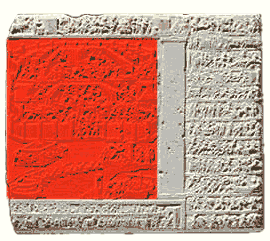 |
 |
A bird's-eye view of Troy is given showing its walls with battlements and towers, and a single gate. Inside we see the temple of Athena standing in the midst of the houses of the town, its precinct flanked on each side with a long colonnade. In the court, the Greeks are issuing from the wooden horse (ΔΟΥΡΗΟΣ ΙΠΠΟΣ) and have already begun the massacre. On the steps of the temple itself Ajax is dragging Cassandra by the hair, while she vainly implores the help of the goddess. A Trojan archer lurking behind the temple aims his bow at Ajax. Outside the precinct are other Greeks, who have been let in at the gates, hastening to the fight.
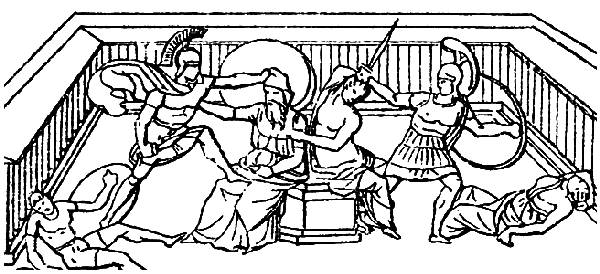 |
Below, the courtyard of Priam's palace is shown surrounded by a colonnade. Priam himself, seated on the altar, is being slain by Neoptolemus, while Hecuba beside him is being dragged away by a rough Greek. On the ground lie the dead bodies of Astyanax and one of Priam's daughters.
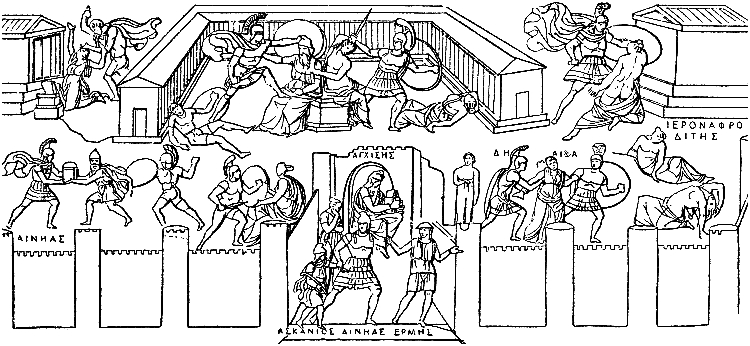 |
Outside the palace are two temples. That on the right is Aphrodite's (ΙΕΡΟΝ ΑΦΡΟΔΙΤΗΣ) and Menelaus is in front of it in the act of slaying Helen (who however was saved at the last moment by Aphrodite). Before the other temple, which is unnamed, a Greek is slaying a maiden near an altar. Below this, Aeneas (ΑΙΝΗΑΣ) and a priest escape with the household gods while, on the right Aethra (ΑΙ--Α) is led away by her grandsons Demophon (ΔΗ--) and Acamas who have recognised her and rescue her from slavery. In the centre of the wall is the Scaean gate, out of which Aeneas (ΑΙΝΗΑΣ) issues, led by Hermes (ΕΡΜΗΣ) carrying his father (ΑΓΧΕΙΣΗΣ) and the household gods, and leading Ascanius (ΑΣΚΑΝΙΟΣ) by the hand while Creusa follows weeping. | 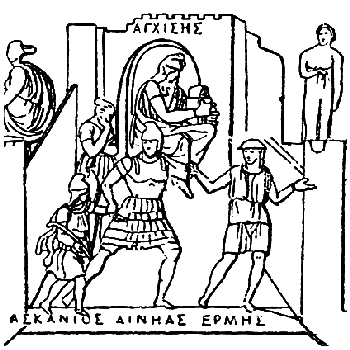 |
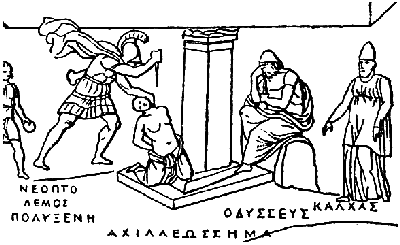 | Outside the gate are two tombs ; on the right that of Achilles (ΑΧΙΛΛΕΩΣΣΗΜΑ) at which Neoptolemus (ΝΕΟΠΤΟΛΕΜΟΣ) is sacrificing Polyxena (ΠΟΛΥΞΕΝΗ), while Odysseus (ΟΔΥΣΣΕΥΣ) sits near, with Calchas (ΚΑΛΧΑΣ) beside him. |
On the left is Hector's tomb (ΕΚΤΟΠΟΣ ΤΑΦΟΣ) which is very badly restored in fig. 93, the central mound having been misunderstood. Round it are grouped Talthybius (ΤΑΛΘΥΒΙΟΣ) the herald and the captive Trojan women (ΤΡΩΑΔΕΣ) Andromache (ΑΝΔΡΟΜΑΧΗ), Cassandra (ΚΑΣΣΑΝΔΡΑ) and Helenus (ΕΛΕΝΟΣ) sit on the steps at the foot. A second scene is shown on the side steps ; Odysseus has come to tell Hecuba (ΕΚΑΒΗ), who is accompanied by Polyxena (ΠΟΛΥΞΕΝΗ) Andromache (ΑΝΔΡΟΜΑΧΗ) and Helenus (ΕΛΕΝΟΣ), that Polyxena must die.
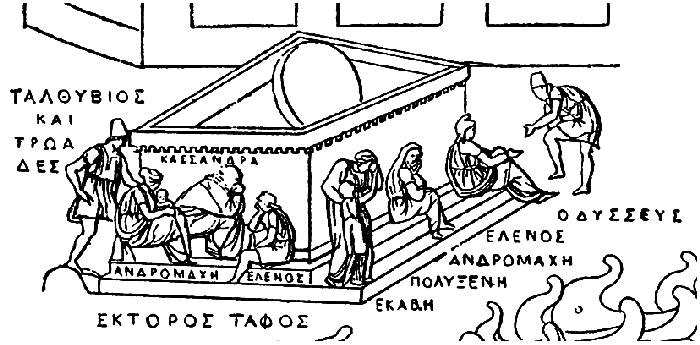 |
Below the tombs is the seashore where the ships of the Greeks (ΝΑΥΣΤΑΘΜΟΝ ΑΧΑΙΩΝ) lie drawn up on the beach, while on the right is the Sigean headland (ΣΕΙΓΑΙΟΝ) marked by a column,
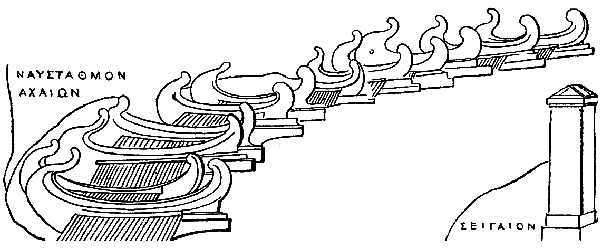 |
near which Aeneas is embarking (ΑΠΟΠΛΟΥΣ ΑΙΝΗΟΥ) ; Anchises with his sacred load (ΑΓΧΙΣΗΣ ΚΑΙ ΤΑ ΙΕΡΑ) is on the gangway, followed by the pilot Misenus (ΜΙΣΗΝΟΣ) with his steering paddle.
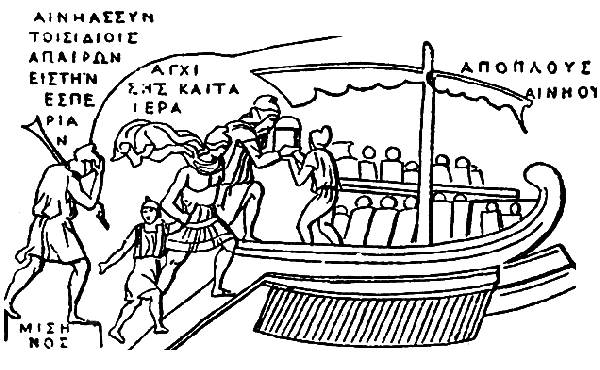 |
Iliad, above and on the side.
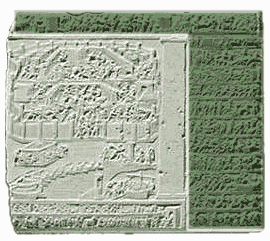 |
A, in the frieze, (1) lines 10-21. The first scene, Ἀγαμέμνων, Χρύσης, Ἄποινα, showing Chryses on his knees before Agamemnon is lost in this, but preserved on another tablet ;
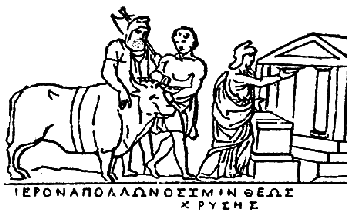 | (2) lines 34-42, Ἱερὸν Ἀπόλλωνος Σμινθέως, Χρύσης, Chryses offers sacrifice to Apollo and prays for vengeance. |
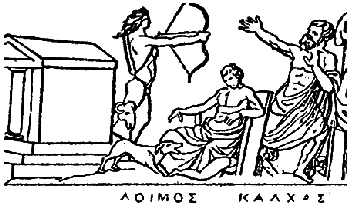 | (3) lines 43-52, Λοιμός. Apollo shoots on the Greeks, sending the plague. (4) line 93, Κάλχας, Calchas, the seer, has a vision of the god destroying the army. He starts back in terror. |
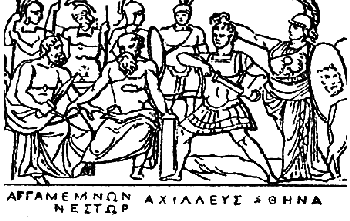 | (5) line 194, Ἀγαμέμνων, Νέστωρ, Ἀχιλλεύς, Ἀθηνᾶ. The council of the Greeks. Achilles rushes to slay Agamemnon, but is held back by Athena, who seizes the hair of his head, while Nestor checks Agamemnon. |
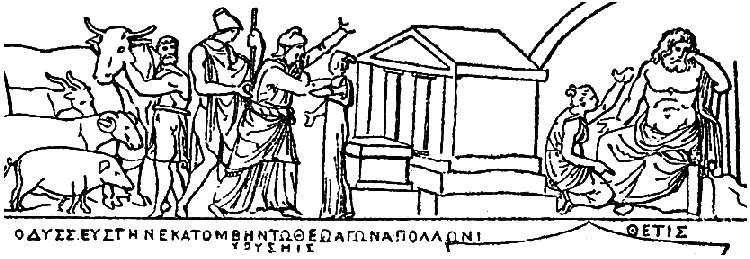 |
(6) lines 430-456, Ὀδυσσεὺς τὴν ἑκατόμβην τῷ θεῷ ἄγων Ἀπόλλωνι. Χρυσηίς. Odysseus appeases the god with a hecatomb, (wrongly restored as though it were the Roman suovetaurilia) and restores his daughter to Chyses. (7) lines 497 foll., Θέτις. Thetis on Olympus, indicated by a rainbow (?), pleads for her son before Zeus.
Parts of B to K are supplied by the fragment of a "tabula" mentioned above (cf. Jahn, loc. cit. Pl. 2, Engelmann-Anderson, l.c. fig. 3).
 |
Ν at the bottom, (1) line 567 foll., Μηριόνης, Ἀκάμας, Meriones slays Acamas (badly restored). (2) lines 363 foll., Ἰδομενεύς, Ὀθριονεύς, Ἄσιος ; Idomeneus rushes to slay Othryoneus, whom Asius is supporting ; (3) line 541 foll., Αἰνήας, Ἀφαρεύς. Aeneas pursues Aphareus.
 |
Ξ (1) line 463, Ἀρχέλοχος, Αἴας Λοκρός. Ajax raises his sword to cut down Archelochus who has come to rescue Satnius (omitted in the restoration). (2) Αἴας, Ποσιδῶν, Ἕκτωρ, Ἀπόλλων. Ajax fights aided by Poseidon, Hector aided by Apollo, a scene which only corresponds in a general way with the text as we have it.
 |
Ο Ἐπὶ ναυσὶ μάχη. The Battle at the ships with the chief combatants, Ajax with his spear and Teucer with his bow standing in the poop, while Hector (Ἕκτωρ) hurls a torch at the ship (line 718). Caletor (Καλήτωρ) slain by Ajax lies dead at Hector's feet. Helenus, Clitus, Paris and Aeneas (Ἕλενος, Κλίτος, Πάρις, Αἰνήας) stand on the rising ground shooting arrows at the ships.
 |
Π. (1) line 130, Πάτροκ. Patroclus arming. (2) Φοίνιξ, Διομήδης, Ἀχιλλεύς. Diomede and Phoenix visit Achilles, a scene not found in the Iliad. (3) line 731, Πάτροκλος. Hector pursues Patroclus.
 |
Ρ (1) line 125, Hector attacks Ajax, who defends the body of Patroclus. (2) line 717, Menelaus and Meriones lift the body into the chariot. They are attended by two men, probably Automedon and Alcimedon. This disagrees with Homer, who makes Menelaus carry the body on his shoulders.
 |
Σ (1) line 233, Ἀχιλλεύς, Πάτροκλος. Achilles seated at the foot of the bier weeps over Patroclus ; a boy (Automedon) and a maid join in the lamentation. (2) line 367; Θέτις. Thetis and one of her attendant nymphs on their way to Hephaestus. (3) line 478, Ὁπλοποία, Ἥφαιστος. Hephaestus and three Cyclopes forge the shield.
 |
Τ (1) line 3, Θέτις, Ἀχιλλεύς, Φοίνιξ. Achilles putting on the armour brought by Thetis. (2) line 397, Ἀχιλλεύς. Achilles mounting his chariot.
 |
Υ. (1) line 318 foll., Ποσιδῶν. Poseidon urges Aeneas to fly. (2) Ἀχιλλεύς. Achilles rushes with drawn sword against a Trojan (perhaps Polydorus, line 407). (3) Hector (?) retreating. (4) a confused group.
 |
Φ (1) line 114, Σκάμανδρος. Achilles slays Lycaon on the banks of the Scamander. (2) line 284, Ποσιδῶν, Ἀχιλλεύς. Poseidon holding a trident pulls Achilles from the waters of the river. (3) line 606, Φρύγες. The Trojans pursued by Achilles fly in terror to the city gates.
 |
Χ (1) line 35, Ἀχιλλεύς. Hector stands at the gate awaiting Achilles. (2) line 368, Ἕκτωρ, Ἀχιλλεύς. Achilles pulls the helmet from Hector's lifeless head. (3) line 395, Ἀχιλλεύς. Achilles drags Hector's body behind his chariot to the ships.
 |
Ψ (1) line 165, Καῦσις Πατρόκλου. Patroclus's body on the funeral pyre which Achilles is on the point of lighting. (2) line 287, Ἐπιτάφιος Ἀγων. The funeral games ; chariots racing.
 |
Ω (1) line 471 Ἀχιλλεύς, Πρίαμος, Ἕρμης. The tent of Achilles is indicated by a curtain hanging from pillars. Priam kneels at the feet of Achilles. Phoenix stands by, though in Homer he does not enter the tent. (2) Ἕκτωρ καὶ λύτρα Ἕκτωρος. Hector's dead body is being raised on the cart while the ransom is carried into the tent.
Aethiopis on the basis supporting the pillars.
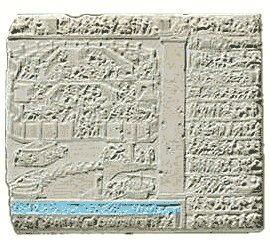 |
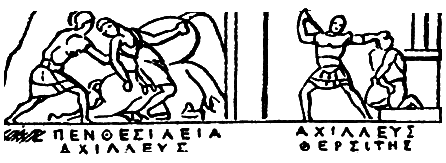 |
(1) …ΚΗΣ. Achilles slays Podarces. (2) Πενθεσίλεια, Ἀχιλλεύς. Achilles slays Penthesilea. (3) Ἀχιλλεύς, Θερσίτης. Achilles slays Thersites at the tomb of Penthesilea. |
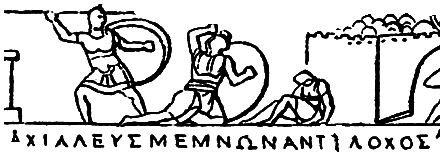 |
(4) Ἀχιλλεύς, Μέμνων, Ἀντίλοχος. Achilles slays Memnon, behind whom lies Antilochus. He had saved his father Nestor's life at the cost of his own by receiving the spear of Memnon in his breast. |
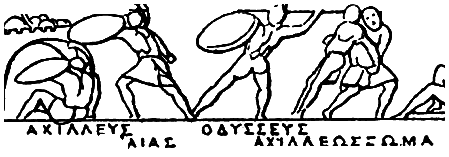 |
(5) Ἀχιλλεύς, Αἴας. Achilles falling wounded at the Scaean gate beneath the walls of Troy ; Ajax defending him. (6) Ὀδυσσεύς, Ἀχιλλέως σῶμα. Ajax fighting, while Odysseus carries the body of Achilles from the battle-field. |
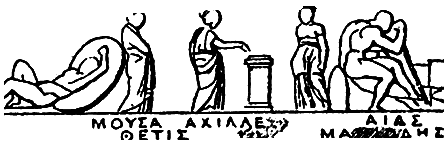 |
(7) Μοῦσα. The muse (wrongly restored facing right) mourning over Achilles. (8) Θέτις, Ἀχίλλ[ειον ?]. Thetis pouring a libation at the tomb of Achilles, near which is a damaged figure (his shade ?). (9) Αἴας μα[νιώ]δης. Ajax seated on a stone in deep dejection. |
Little Iliad of Lesches, on lower row of basis :
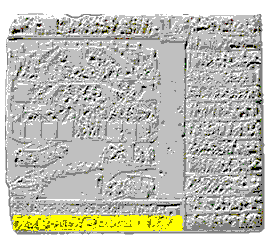 |
 |
(1) Paris falling, wounded by the arrow of Philoctetes. (2) Two figures sacrificing at an altar, perhaps Priam making a treaty with Eurypylus, son of Telephus. (3) Ἐυρύπυλος, Νεοπτόλεμος. Neoptolemus slays Eurypylus. (4) Ὀδυσσεύς, Διομήδης, Παλάς. Odysseus and Diomede carry off the Palladium.
 |
(5) Δούρηος ἵππος, Τρώαδες καὶ Φρῦγες ἀνάγουσι τὸν ἵππον, Πρίαμος, Σίνων, Κασσάνδρα, Σκαιὰ πύλη. The bringing of the wooden horse into Troy. The scene corresponds very closely with Virgil's description (Aeneid, II. 234-49). The Trojans drag the huge beast along with a hawser, Priam leading the way and the spectators dancing with delight. Sinon, whose bonds are being untied, is near Priam. Cassandra, the only one who foresees the coming doom, stands in an ecstasy of frenzied horror at the Scaean gate. There is a wall-painting from Pompeii in the Naples Museum. which has a scene almost identical with this (cf Ant. d. Ercolano, III., Pl. 40, Engelmann-Anderson, loc. cit. Od. fig. 33). | 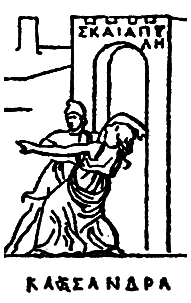 |